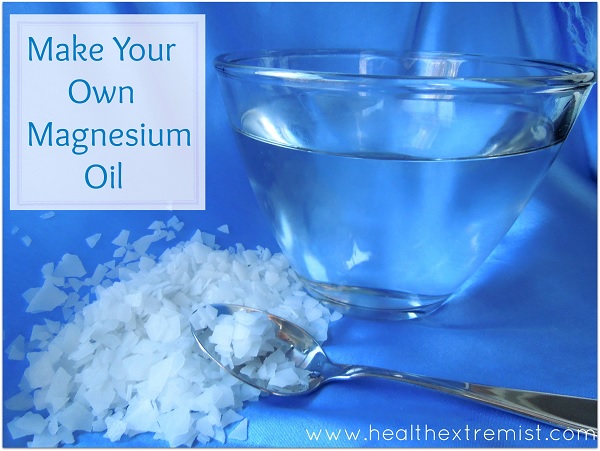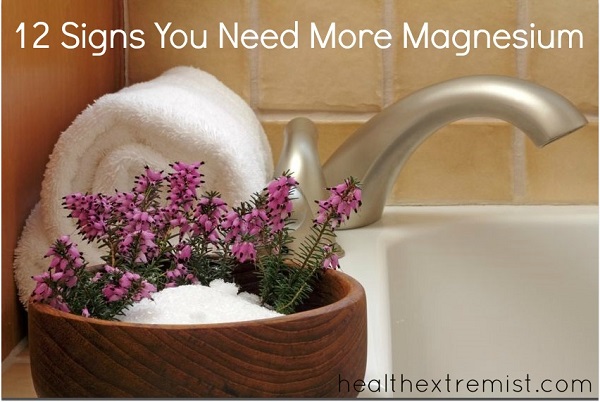How To Make Magnesium Oil

Make Your Own Magnesium Oil
Over the past year or so I have been pretty much been obsessed with Epsom salts, which are used to boost your magnesium levels. Even though I had come across many posts and comments on magnesium oil, it wasn’t until about three months ago that I started researching what it is and how to make magnesium oil. I know what you’re thinking, where have I been right?, how could I not know about magnesium oil?! Well, after this post, now you will know all about it too!
Why You Need Magnesium
It is estimated that 90% of Americans are deficient in magnesium. Unfortunately, even when eating an optimal diet it is hard to get enough magnesium due to difficulty absorbing the mineral and the minimal amount in our farming soil.
Magnesium is also depleted from our bodies when we are under stress, experience anxiety or have a lack of sleep. Anxiety is one of the reasons why I am always trying to increase my magnesium levels while trying to maintain a good balance.
Between the factors of diet, stress, and those we can’t control such as low levels of magnesium in farming soil, it is easy to see why so many are deficient in this mineral.
A Few Of The Most Common Symptoms Of Magnesium Deficiency Include:
Fatigue
Low Energy
Difficulty Sleeping
PMS and Hormonal Imbalances
Headaches
Anxiety
Low Energy
Difficulty Sleeping
PMS and Hormonal Imbalances
Headaches
Anxiety
There are a couple of ways you can increase you magnesium level, you can use Epsom salts, magnesium oil, take a dip in the ocean (the ocean is a great source of magnesium and trace minerals), take a magnesium supplement, increase your intake of magnesium rich foods, or do a combination to make sure you are getting optimal absorption.
Using trans-dermal magnesium (applied to your skin) is the most effective way to boost your magnesium level and ensure absorption, such as using magnesium oil or Epsom salts.
Magnesium Oil Vs. Epsom Salts
Epsom salts, which are magnesium sulfate is most commonly added to baths and significantly increases your level of magnesium. Magnesium Oil is actually magnesium chloride, it is a different form of magnesium which has been noted to be more easily absorbed. The funny thing is, it actually isn’t an oil at all! It is just a mixture of magnesium flakes and water. Magnesium Oil has been said to be even more readily absorbed than Epsom salts.
Why You Should Make Your Own Magnesium Oil
Magnesium oil can be quite expensive, making your own magnesium oil will help cut back the cost. Also, another very important benefit of making your own magnesium oil is that you can adjust how potent you make the mixture. You can do this by adjusting the amount of magnesium flakes in your mixture for magnesium oil. When you are first starting out you may want to start with ¼ of magnesium flakes and see how your body responds to the magnesium oil and adjust the amount until you find the right one for you.
How To Make Magnesium Oil
-What You Need
-1/2 cup of Magnesium Flakes
-1/2 cup of Water
-Jar or Spray Bottle to Store the Mixture
-1/2 cup of Water
-Jar or Spray Bottle to Store the Mixture
-Magnesium Oil Directions
- Heat up ½ cup of water (not to the point of boiling)
- Pour the water over ½ cup of magnesium flakes
- Stir the mixture until the magnesium flakes are dissolved.
- Let the mixture cool and store in a spray bottle or jar
- You can apply the mixture to your skin after it has cooled enough to a comfortable temperature. You can also store the magnesium oil for future use
*Many use the magnesium oil several times per day, using anywhere from 10 to 20 sprays spaced throughout.
*For optimal absorption spray/apply the magnesium oil to your stomach area and arms and legs.
*If you find that the application of magnesium oil tingles or stings, you can dilute the mixture by adding more water.
How Magnesium Oil Has Worked For Me
My results with magnesium oil have been absolutely amazing, which is why I couldn’t wait to share this post with you! I use the magnesium oil daily, since I’m not a huge fan of using plastic spray bottles, I keep my magnesium oil stored in a jar and use a small cloth to apply it to my skin. After starting to use magnesium oil, I have noticed a huge improvement, well actually, many improvements, I have less difficulty sleeping and my anxiety/nervousness is almost non-existent! Since I was using Epsom salts for almost a year and my results were not quite as stellar, as many have noted, the magnesium oil can provide more benefits as it can be more easily absorbed. Not to say that Epsom salts are not effective, they are absolutely helpful and I continue to use them at least once a week.
Do you use magnesium oil or Epsom salts? Have you seen any improvements from using magnesium oil?



